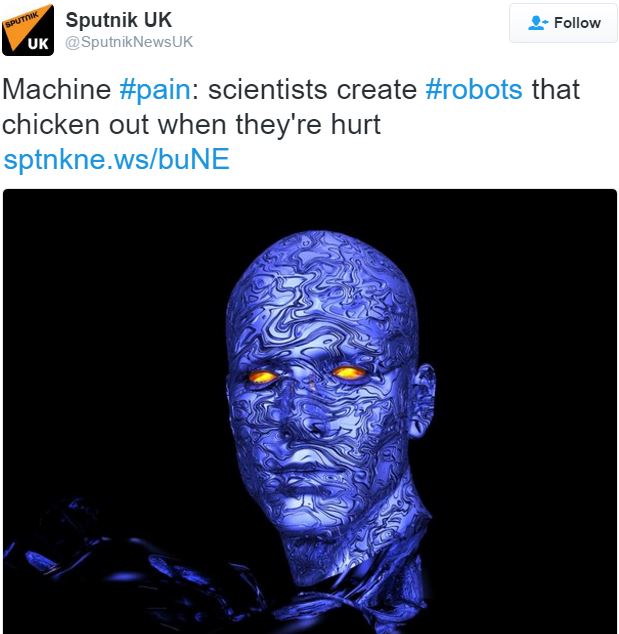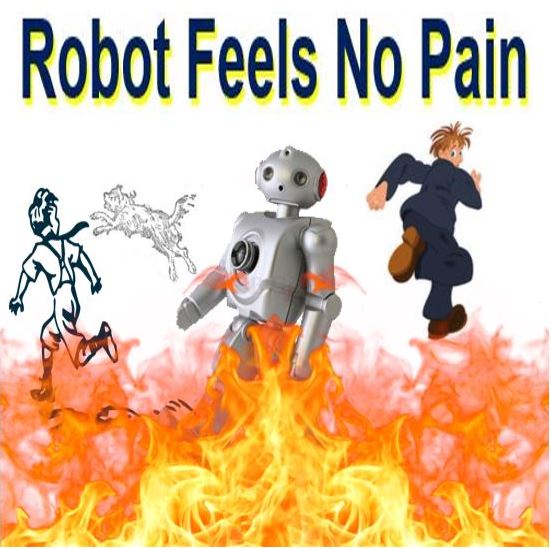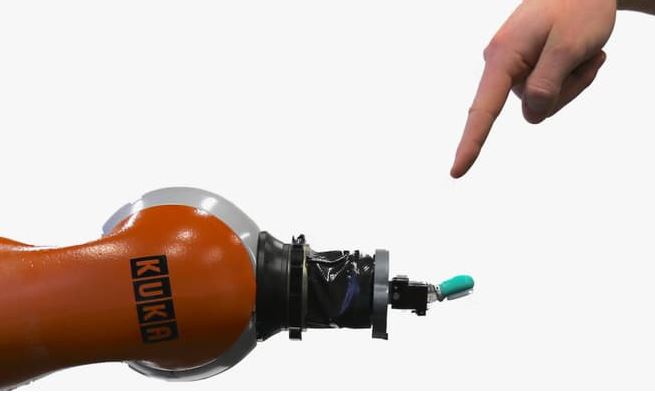Robots are being taught to feel pain by two German scientists who believe that reacting to pain could be good for their capabilities and work performance. To date, most people have thought that not being able to feel pain is an advantage – the logic being that robots can be sent into dangerous or hostile environments that humans would not tolerate.
Johannes Kuehn and Sami Haddadin, both from Leibniz University of Hannover, are developing a synthetic nervous system to teach robots how to sense pain. Their logic is that if robots feel pain they can quickly respond and avoid any potential damage to their electronics, gears or motors.
The researchers presented their project at the IEEE International Conference on Robotics and Automation (ICRA) in Stockholm, Sweden, last week. Several people asked them why on Earth they would want to give robots the ability to feel pain.
 News about the robot being taught to feel pain has spread across the world in social media websites. (Image: twitter.com/SputnikNewsUK)
News about the robot being taught to feel pain has spread across the world in social media websites. (Image: twitter.com/SputnikNewsUK)
Pain-sensing robots safer for humans
Mr. Kuehn, a Doctoral Research Assistant at the Leibniz’ Institute of Automatic Control with Prof. Dr. Haddadin, a world-leading expert on physical human-robot interaction and safety, explained that pain is a system that protects humans, which would also protect robots.
What is a robot?
Mr. Kuehn said:
“Pain is a system that protects us. When we evade from the source of pain, it helps us not get hurt.”
Humans with congenital analgesia – an inherited and very rare condition in which a person cannot feel physical pain – get injured significantly more often than the rest of the population, because their bodies do not instinctively react to things that would harm us.
 The boy’s, man’s and dog’s ability to feel pain made them run away from the fire. The robot stayed, because it felt no pain. The robot was destroyed by the fire, while the boy, man and dog survived. If the robot had felt pain, it would have run away too and would not have been destroyed.
The boy’s, man’s and dog’s ability to feel pain made them run away from the fire. The robot stayed, because it felt no pain. The robot was destroyed by the fire, while the boy, man and dog survived. If the robot had felt pain, it would have run away too and would not have been destroyed.
Mr. Kuehn argues that by protecting robots from damage, their system will also be protecting us, because more and more robots are and will be operating alongside human workers, and undetected damages and faults in robotic equipment can lead to accidents that harm people.
Robot’s pain sensor bio-inspired
The researchers reasoned that if human mechanisms to send and respond to pain are so effective, then perhaps we should devise a bio-inspired robot controller that works along similar mechanisms. The controller would have to reflexively react to protect the machine from potentially damaging interactions or environments.
This is not the first time somebody has thought of creating a reflex controller for robots. A team from Stanford University and the University of Rome-La Sapienza created one five years ago. In that case the controller helped a robot arm avoid collisions with humans.
 During their demonstration, Mr. Kuehn and Dr. Haddadin showed how the robot differentiates between light, moderate and severe pain. (Image: YouTube).
During their demonstration, Mr. Kuehn and Dr. Haddadin showed how the robot differentiates between light, moderate and severe pain. (Image: YouTube).
IEEE Spectrum quoted Mr. Kuehn and Dr.Haddadin, who wrote in their paper:
“A robot needs to be able to detect and classify unforeseen physical states and disturbances, rate the potential damage they may cause to it, and initiate appropriate countermeasures, i.e., reflexes. In order to tackle this demanding requirement, the human antetype shall serve as our inspiration, meaning that human pain-reflex movements are used for designing according robot pain sensation models and reaction controls.”
“We focus on the formalization of robot pain, based on insights from human pain research, as an interpretation of tactile sensation.”
The robot has a tactile system that is inspired by the human skin structure to determine how much pain the machine should feel for a given amount of force. As in the case with human neurons, the model transmits pain data in repetitive spikes if the force is greater than a certain threshold. The pain controller reacts after classifying the data as light, moderate or severe pain.
Video – Teaching a robot to feel pain
In this IEEE Spectrum video, you can see a robot responding to varying degrees of pain.
